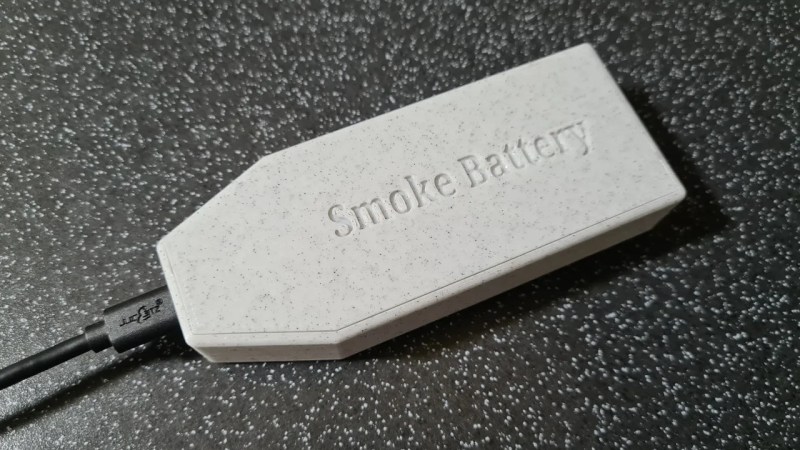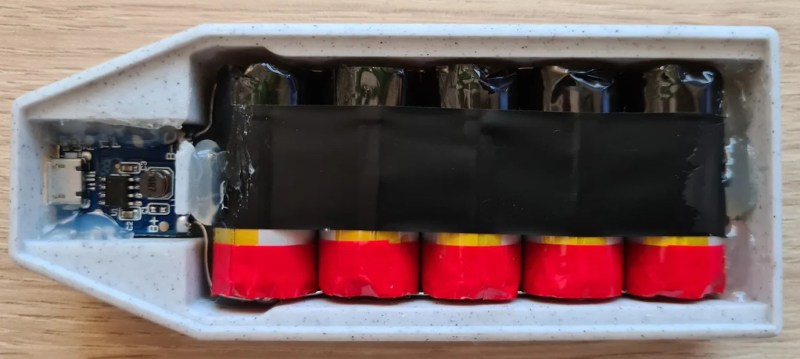It’s another one of those fun quirks about our increasingly cyberpunk world — instead of cigarette butts littering our streets, you’re more likely to find disposable vaporizers that have run out of juice. Unfortunately, while the relatively harmless paper remnants of a cig would eventually just fall apart when exposed to the elements, these futuristic caltrops are not only potentially explosive thanks to their internal lithium-ion battery but aren’t going anywhere without some human intervention.
So do the environment and your parts bin a favor: pick them up and salvage their internal cells. As [N-Ender_3] shows with this build, it’s cheap and easy to turn the remnants of a few vapes into a useful USB power bank. In this case, the enclosure is 3D printed, which makes it particularly form-fitting, but you could just as easily pack the cells into something else if you’re not a fan of extruded plastic.
The real star of the show here is an off-the-shelf USB power bank module, which handles safely charging the parallel-wired cells and stepping up the output to 5 V. As explained by [N-Ender_3] in the project description, there is a bit of a caveat here, though — you have to first charge all the cells up (after verifying they’re intact and working in the first place) fully before soldering them together. This simplistic charge module has no ability to individually balance the cells, so if they’re not all within 0.1 V or so of each other, things will start to go south on you.
As always, there’s a level of risk when working with lithium-ion batteries, but we figure they’re less likely to explode when properly repurposed than they are sitting on the street waiting to be run over. Probably.
















OK. so the module supplies 5V from the batteries. But how does on charge them?
Wouldnt something like this be better: https://www.amazon.com/Battery-Charger-Discharge-Integrated-Lithium/dp/B098989NRZ/ref=pd_lpo_sccl_3/142-2551966-3076462?pd_rd_w=LTrb5&content-id=amzn1.sym.116f529c-aa4d-4763-b2b6-4d614ec7dc00&pf_rd_p=116f529c-aa4d-4763-b2b6-4d614ec7dc00&pf_rd_r=K9NCK3YPNX35FMC1251J&pd_rd_wg=Hr5TE&pd_rd_r=9cafacc2-8e33-461e-aa3d-3f6936d176be&pd_rd_i=B098989NRZ&psc=1
The said module is a charger AND a booster.
Just click the link to printables where there is a BOM with a link to the module
Your answer is just 1 click away. He uses an “USB Charge Power Bank Module Circuit Board 134N3P” module… So it does handle charging and boosting to 5V.
Those modules look quite flimsy tbh. It says current max. 1A. I’d guess voltage will sag well below 5V @0.5…0.6A…
That’s what the USB-Micro port you can see in the picture is for.
You can get bi-directional USB-C modules now (recharge via USB, USB-C power out) that also do the QC & PD stuff.
I’ve ordered some, not yet played with them.
Lol, smoke battery. I sense some foreshadowing…
“relatively harmless paper remnants of a cig”
RELATIVELY harmless.. yes. I just think if that is to be mentioned then it should also be mentioned that while paper does degrade the fibers in the filters not so much. I’ve seen urban rivers where the bottom had more butts than stones. They wash in from the storm drains when people throw them out their cars and collect over many years.
If you must smoke… throw your butts away properly.
…or train crows to throw them away for you ;)
No don’t expose our Corvus friends to the toxic waste by products of tobacco industry. And certainly do train them to go hunting for said waste.
Or smoke filterless. Pressing too hard or constricting airflow too much actually makes smoking worse with a filter. People don’t hold them quite like the testing machines do.
Yeah the butts are allll plastic baby
They’re also full of chemicals, including heavy metals, which strongly pollute soils and rivers.
One thing I’ve never quite figured out is – why solder cells together? Plenty of devices, from toys on up, use spring battery connectors for replacing cells. Why can’t we do that with these, other than it taking up slightly more room?
Using pressure based contacts for lithium cells is not acceptable for many reasons including the added fire risk. These cells are already unstable bombs waiting to go off, you don’t want to increase the already very significant chance of inextinguishable fire (as compared to non lithium cells) by adding a contact point which can oxidize or otherwise fail, causing higher resistance, causing high heat dissipation at that junction. Etc
As the original person was saying, plenty of devices use spring contacts on one or both sides with lithium cells. Even pretty high current devices, though they generally use short fat springs that minimize resistance. Generally, and partly for other reasons, if there’s more than one cell then they will be held individually rather than stacked touching each other like old flashlights.
I am inclined to agree. In fact it turns out these cells (or full fledged batteries) typically wear special tabs that were spot welded on them using a specialized device. All of my packs either use batteries in holders, or two with the JST connectors attached and wired in series. The one big pack I use for the Raspberry Pi work is attached to a booster board from Adafruit.
One benefit of using wires is that they can act as fuseable links between parallel cells. Should a cell short out, instead of having all the other cells dump all of their energy into the cell, the link wire burns out. The fusing current and time of the wire needs to be calculated for the conditions and the pack needs to be arranged in a way that the burning link doesn’t cause further problems.
Pouch cells ( including the cylindrical (shaped) pouch cells in the post) should not be crushed or squeezed in any way so that rules out spring terminals. Cylinderical cells such as 18650s, etc are fine for spring cell holders however I find that some cells have varying length depending if they have protection circuitry (beyond the typical CID).
Spring contacts make sense when you frequently remove and replace cells but lithium cells which are charged in-situ don’t need to be removed frequently so it’s not the same situation.
I have an increasing supply of various capacities of cells from these damned e-waste. This seems like a good use for them, pity I already have a bunch of USB powerbanks.
FYI, you should put some charge into those before storing them away. Lithium cell capacity degrades faster over time when kept in a low state of charge. Optimum state of charge is 40%. Charging them to their nominal voltage (usually) 3.7 V would also be okay to minimise degradation during storage.
Maybe you could sell them on eBay for collection-only?
You don’t need cel balancing, since they are all connected in parallel. They also don’t need to be full, they just need to have about the same voltage, connecting a full and an empty cell in parallel would cause a significant equalization current to flow, but if the voltages are about the same (preferably near empty, to reduce the stored energy), it will be fine.
This is all kinds of poor planning.
Imaging a cell developing a short, let me know how you think that’ll go.
I wouldn’t betting any long term QC on cells from devices intended to be tossed out.
Also, the hypocrisy from gen z using rechargeable (really disposable) vape devices isn’t lost on me.
About as well as a cell in a power tool pack developing a short. Or a cell in a laptop battery pack developing a short, or ….. There are literally millions of lithium powered batteries where the cells are all permanently wired in a series/parallel set to get increased voltage. How much do you worry about them?
Candles cause about 3% of house fires which is about the same as lithium-battery fires. Many people, and fire departments, also think candles are unsafe. Also, the number of fires caused by lithium-cells is growing with the proliferation of devices. It’s not unreasonable to be concerned.
Someone on Reddit posted their project and says they put an SMD fuse on each cell which might help to limit the chaos if one cell develops a short.
When assembling packs of parallel lithium ion cells, I connect all of them together through resistors for some time before soldering/welding, allowing the voltages to perfectly level, thus reducing the equalization current to zero.
I recently discovered just how many discarded vapes are lying around. This morning I had 15 minutes to kill and went for a wander of about 1 mile. Found 5 in good condition and 1 squashed which I dumped in a battery recycling bin. I’m worried I’m starting to hoard them for no good reason. I’ve been wondering if there are any more inventive uses for them.
Despite having no under-voltage cutoff, the one’s I’ve found have all been around the 3.6V mark. They seem OK to re-use, but there’s always the nagging worry that they’re in disposable vapes because they didn’t pass QA to be used in a rechargeable device.
No, it’s jsut that the profit margins on these vapes is high enough to justify treating a rechargeable battery as disposable.
I got over 300 of these batteries and just laying there, just don’t know what to do with them?
I have collected a fair number of these over the last couple of years. They really come into their own this time of year. I typically solder a female JST connector onto them. The get strings of battery powered led strings, cut off the battery holder, add a male JST connector and resistor, and cheap decoration is mine!
The key word here is disposable. Sooo…. very evil for the environment. And supporting a extremely evil indulgence.
I’m old enough to remember when there were “battery packs” and “accu packs” rather than “power banks”. 🙄😂